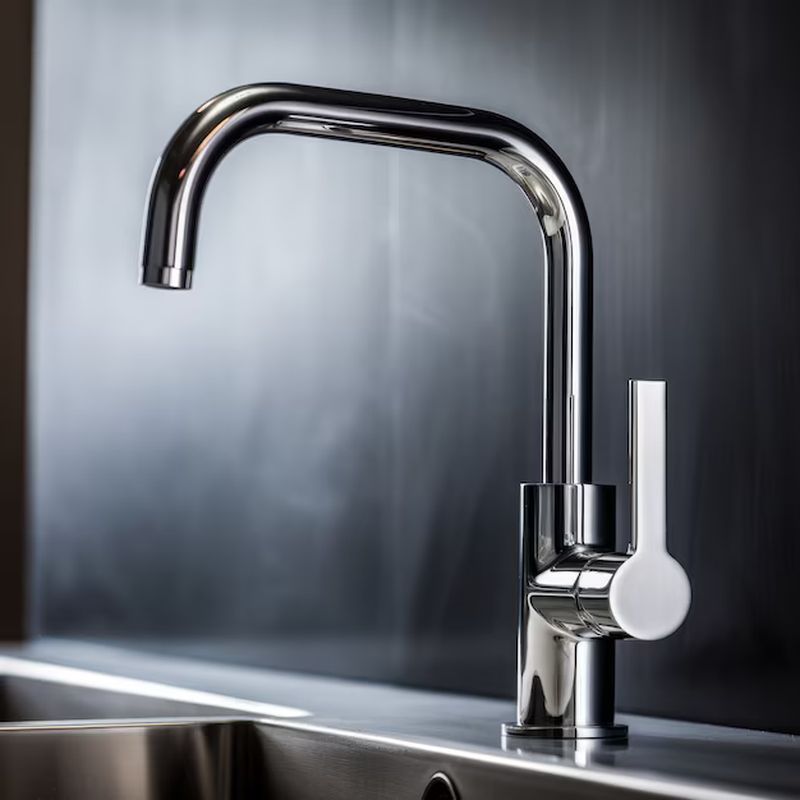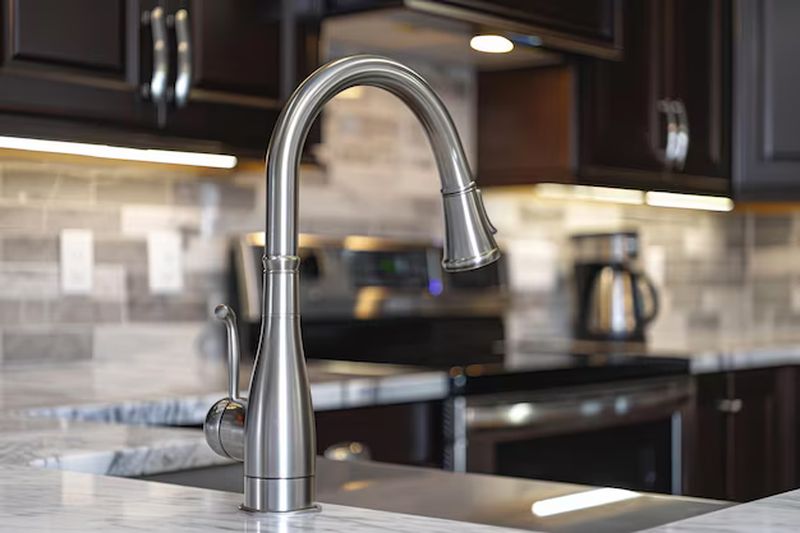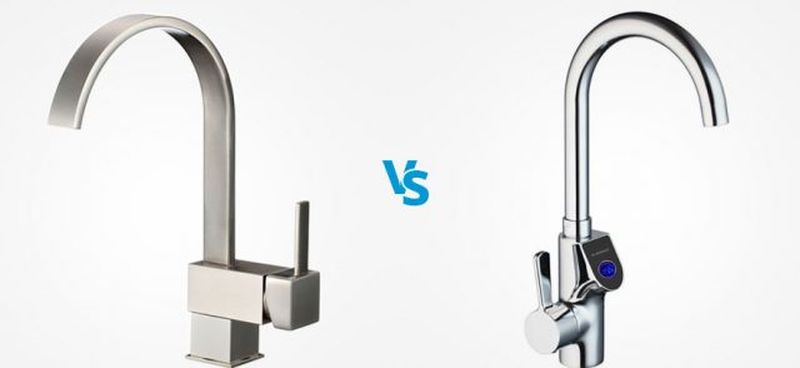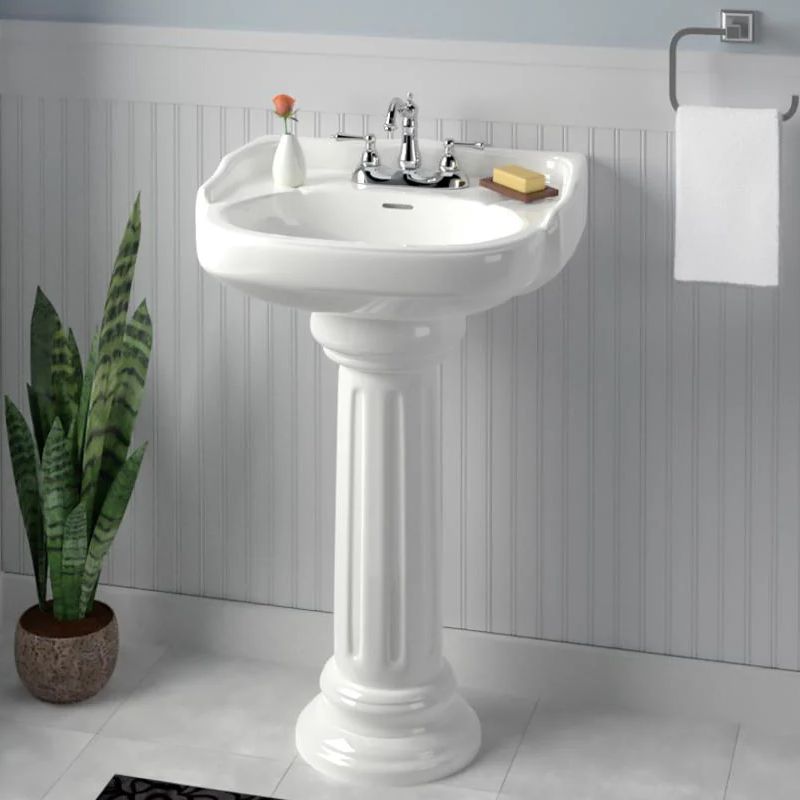 English
English
Jabra Sanitary is a sanitaryware supplier offering toilets, sinks, faucets, bathtubs, etc., at competitive prices. If you're a distributor, wholesaler, or project contractor, get a quote today!
 $23.9 Limited-time Offer
$23.9 Limited-time Offer Consignment Policy
Consignment Policy 20 Years of Experience
20 Years of Experience
When choosing the right finish for your home fixtures, brushed nickel and stainless steel are two of the most popular options. Both have their unique qualities, making them suitable for different applications in your kitchen, bathroom, and other areas.
Whether you're updating your faucet, kitchen sink, or other home appliances, understanding the differences between brushed nickel and stainless steel can help you make an informed decision.
In this article, we'll explore the key differences between brushed nickel and stainless steel, including their composition, aesthetic appeal, durability, maintenance, cost, and applications.

Table of Contents
Is Brushed Nickel and Stainless Steel the Same? The Key Differences
What is Brushed Nickel?
What is Stainless Steel?
Composition and Features: Brushed Nickel vs Stainless Steel
Aesthetic Appeal: Brushed Nickel Compared to Stainless Steel
Durability: Is Brushed Nickel Better Than Stainless Steel?
Maintenance: Brushed Nickel Versus Stainless Steel
Cost and Value Comparison: Brushed Nickel or Stainless Steel?
Application: What is the Difference Between Brushed Nickel and Satin Nickel?
FAQs
Conclusion: Making the Right Finish Choice for Your Home
Is Brushed Nickel and Stainless Steel the Same? The Key Differences
No, brushed nickel and stainless steel are not the same, although they can appear similar visually. The key difference is that brushed nickel is a plating process applied to a base metal, usually brass or copper, creating a nickel finish with a brushed texture.
Stainless steel is an alloy of metals like iron, chromium, and often nickel. It is a solid metal with a distinct composition and inherent corrosion resistance.
Here is a breakdown:
Composition and Features: Brushed Nickel vs Stainless Steel
Feature |
Brushed Nickel |
Stainless Steel |
|---|---|---|
Composition |
Brushed nickel is made by applying a layer of nickel plating over a base metal (such as brass or steel). |
Stainless steel is an alloy primarily composed of iron and chromium. |
Features |
The brushing process creates a textured surface, giving the finish a subtle and matte appearance. This technique also helps reduce the visibility of fingerprints and water spots, making it ideal for high-use areas. |
The chromium content gives stainless steel its remarkable resistance to rust and corrosion. Depending on the specific type, stainless steel can also include other metals like nickel or molybdenum to enhance its properties, such as strength and resistance to wear. |
Aesthetic Appeal: Brushed Nickel Compared to Stainless Steel
| Aspect | Brushed Nickel | Stainless Steel |
|---|---|---|
Finish and Texture |
The matte finish of brushed nickel is soft and muted, with a texture that diffuses light and reduces glare. It's perfect for those who want a finish that is both elegant and understated. |
In contrast, stainless steel has a shiny and reflective surface that adds a modern and industrial feel to any space. The bright and polished finish is eye-catching and gives a sleek and high-end look. |
Color and Appearance |
Brushed nickel typically features warm, slightly brownish hues that work well with traditional, transitional, and contemporary interior designs. It complements darker color schemes and provides a more inviting, cozy atmosphere. |
Stainless steel offers a cooler, metallic tone that leans towards silvery hues. Its clean, bright look is perfect for modern and minimalist spaces where a sleek and polished finish is preferred. |
Design Applicability |
Ideal for spaces where a softer, more rustic, or vintage aesthetic is desired. It pairs well with both traditional and modern designs, offering a versatile look. |
Suited for contemporary and industrial-style designs, stainless steel is perfect for adding a touch of modernity and sophistication to your home. |
What is Brushed Nickel?
Brushed nickel refers to a finish applied to a base metal, often brass or steel. It creates a matte appearance through a brushing technique.
The process of brushing the surface helps reduce the visibility of fingerprints and water spots, which makes brushed nickel a practical choice for high-use areas like kitchens and bathrooms.
The warm tones of brushed nickel give it a timeless and classic appeal that fits well with both modern and traditional design styles.

What is Stainless Steel?
Stainless steel is an alloy primarily composed of iron and chromium, which gives it its remarkable strength and corrosion resistance. The chromium in the alloy forms a thin and invisible layer on the surface.
It prevents rust and corrosion, making stainless steel a durable choice for high-moisture environments. It is often used in kitchen appliances, sinks, and hardware due to its ability to withstand frequent use and exposure to water.

Composition and Features: Brushed Nickel vs Stainless Steel
Understanding the composition of brushed nickel and stainless steel is key to knowing how each material performs and how it fits into your home's design. Let's break down their unique features:
Brushed Nickel
Brushed nickel is an alloy that primarily consists of nickel with additions of copper, zinc, and sometimes iron. The brushing process creates subtle grooves on the surface, which reduces light reflection and helps mask fingerprints, water spots, and minor scratches.
Key Features of Brushed Nickel:
- Brushed nickel is a plating or finish applied to a base metal (such as brass, zinc, or steel).
- It comprises a nickel layer, often with a clear coat to protect the finish.
Stainless Steel
Stainless steel is an alloy composed primarily of iron and chromium, with possible additions of other metals like nickel or molybdenum. This combination of elements gives stainless steel its exceptional strength, corrosion resistance, and ability to withstand extreme conditions.
Key Features of Stainless Steel:
- Stainless steel is an alloy of iron, carbon, and a minimum of 10.5% chromium, which provides corrosion resistance.
- Common grades include 304 (the most common for household items) and 316 (higher corrosion resistance, often used in marine environments).
While both materials are strong and functional, stainless steel generally outperforms brushed nickel in terms of durability, especially in environments with exposure to moisture and wear.
Aesthetic Appeal: Brushed Nickel Compared to Stainless Steel
When it comes to choosing between brushed nickel and stainless steel, aesthetic appeal plays a significant role. Both finishes offer a distinct look.
But they cater to different design preferences and can enhance various interior styles. Let's break down their key differences in finish, texture, color, and overall design applicability.
Finish and Texture
- Brushed Nickel:
Brushed nickel features a soft, muted finish that diffuses light, reducing glare. Its matte texture makes it less prone to showing fingerprints or water spots, which is ideal for high-traffic areas.
The brushing technique also adds a subtle texture to the surface, giving it a more refined, understated look.
- Stainless Steel:
Stainless steel, on the other hand, has a highly reflective surface that contributes to its sleek and modern appearance. The shiny finish creates a bold visual impact, adding a touch of sophistication and luxury to any space.
However, its reflective nature can also make fingerprints and smudges more noticeable, requiring more frequent cleaning.
Color and Appearance
- Brushed Nickel:
Brushed nickel typically has warmer, slightly brownish or gold-toned hues. These warm tones create a more inviting and cozy atmosphere.
It is an excellent choice for traditional, rustic, and even transitional designs. The warm appearance complements wood and other natural materials beautifully.
- Stainless Steel:
Stainless steel offers cooler, silvery tones that bring a modern, industrial feel to your space. The bright, polished surface suits contemporary and minimalist interiors, making it a popular choice for modern kitchens and bathrooms.
Its cool metallic look works especially well in spaces with a clean, crisp design.

Design Applicability
- Brushed Nickel:
The warm and subtle finish of brushed nickel allows it to blend seamlessly into various design themes.
Whether your space is traditional, contemporary, or transitional, brushed nickel can be paired with a wide range of color palettes and materials. It works particularly well with earthy tones, wood finishes, and matte paint colors.
- Stainless Steel:
Stainless steel's reflective and cool-toned appearance makes it more suited to modern and industrial design styles. <Also explore the differences bewteen quartz and stainless steel sinks>
It pairs beautifully with other sleek, contemporary materials like glass, concrete, and glossy finishes. Its bold look is perfect for creating statement pieces in kitchens and bathrooms.
Durability: Is Brushed Nickel Better Than Stainless Steel?
When it comes to durability, both brushed nickel and stainless steel are strong materials. But they perform differently in terms of corrosion resistance, wear, and overall strength.
Let's take a deeper look at how each one fares under typical conditions:
Corrosion Resistance
- Brushed Nickel:
Brushed nickel offers moderate resistance to corrosion. However, it can corrode if not maintained properly, especially in high-moisture environments.
The nickel plating helps protect the base metal. But it is not as resilient as stainless steel when exposed to water or harsh chemicals.
- Stainless Steel:
Stainless steel excels in corrosion resistance, thanks to its high chromium content. This forms a protective layer on the surface, preventing rust and staining, even in humid or wet environments.
This makes stainless steel a more durable option, especially for kitchens, bathrooms, and outdoor applications.
Resistance to Wear
- Brushed Nickel: While brushed nickel has a relatively durable surface, it can show signs of wear over time. The matte finish helps mask scratches and minor damage.
But with frequent use, the surface may start to wear down, requiring more maintenance or even refinishing to restore its appearance.
- Stainless Steel:
Stainless steel is highly resistant to scratches, dents, and other forms of wear. Its smooth, hard surface is less likely to show damage.
So, it is a great option for areas that endure heavy use, such as kitchens and high-traffic commercial spaces. Stainless steel remains intact and visually appealing for a long time.
Strength
- Brushed Nickel:
Brushed nickel is generally strong, but its base metal (usually brass or steel) may not be as resilient as stainless steel. It's a good option for most home applications, but for environments where heavy wear is expected, it may not be as robust.
- Stainless Steel: Stainless steel is significantly stronger than brushed nickel. Its alloy composition gives it superior strength.
Therefore, it is a better choice for fixtures that are subjected to extreme conditions or frequent heavy use. Whether you're looking for durability in appliances, fixtures, or hardware, stainless steel's strength is hard to beat.
Both finishes can last for many years with proper care. But stainless steel tends to outperform brushed nickel in durability, especially in high-use areas. If longevity and resistance to wear are top priorities, stainless steel may be the better investment.

Maintenance: Brushed Nickel Versus Stainless Steel
Both brushed nickel and stainless steel require regular maintenance to ensure their longevity and appearance. However, the level of care needed for each material differs.
Let's explore how to properly maintain these finishes.
For brushed nickel, use a microfiber cloth, warm water, and dishwasher detergent to wipe away marks. You can also apply a layer of paste wax once a month to protect the finish.
Brushed nickel is low maintenance, making it a good choice for busy households. However, it may show scratches over time.
For stainless steel, clean it with a microfiber cloth, warm water, and a mixture of 1 part vinegar to 10 parts water. For stubborn dirt, you can also use a soft brush to help remove the grime.
Stainless steel is durable but more prone to fingerprints and watermarks. To keep stainless steel looking shiny, it should be cleaned regularly.
Cost and Value Comparison: Brushed Nickel or Stainless Steel?
When choosing between brushed nickel and stainless steel, the cost is often a significant factor. Both materials offer distinct advantages and drawbacks when it comes to pricing.
Let's break down the cost and value of each option to help you make a more informed decision:
Pricing
- Brushed Nickel:
Brushed nickel is generally the more affordable option compared to stainless steel. Its production process is less complex, and the material costs are lower.
This makes brushed nickel a popular choice for homeowners on a budget who still want a stylish, durable finish for their fixtures.
- Stainless Steel:
Stainless steel, while offering superior durability and resistance to corrosion, comes with a higher initial price tag. The cost of the material itself is higher, and the manufacturing process is more complex. For those seeking long-term value and a more resilient finish, the additional investment in stainless steel may be worth it.
 Ads
Ads
Small Round Stainless Steel Kitchen Sink
This is the Small Round Stainless Steel Kitchen Sink H09-4242, designed for both functionality and elegance. This small round stainless sink offers a compact yet spacious capacity, perfect for everyday washing while conserving valuable kitchen space.
Quality and Grade
Both brushed nickel and stainless steel come in various grades, with premium options available for both. Here is how to judge the quality and grade:
- Brushed Nickel:
The quality of brushed nickel depends on the thickness of the nickel plating and the base metal used.
Higher-quality brushed nickel finishes have thicker plating, which makes them more durable and resistant to wear and corrosion.
Lower-quality finishes may chip, tarnish, or wear off over time.
- Stainless Steel:
304 Stainless Steel: High-quality, durable, and resistant to rust and corrosion. Suitable for most household applications.
316 Stainless Steel: Premium grade with added molybdenum for enhanced corrosion resistance, ideal for harsh environments.
Lower grades (e.g., 430) are less resistant to corrosion and are typically used for decorative purposes.
Budget Tips
- If you're working within a tight budget, brushed nickel can offer a more affordable solution without sacrificing too much in terms of aesthetics. However, consider the long-term costs. Brushed nickel may require more maintenance to maintain its appearance over time.
- For those with a higher budget, stainless steel offers superior durability and longevity. While the upfront cost is higher, its resistance to wear and corrosion makes it a great investment in the long run. Stainless steel may also require less frequent maintenance, saving you time and money over the years.
When choosing between the two finishes, think about your priorities: are you looking for an affordable option that still looks great, or are you willing to invest more for the added durability and long-term performance of stainless steel?

Application: What is the Difference Between Brushed Nickel and Satin Nickel?
Brushed nickel and satin nickel are similar in application. But they are suitable for different kitchen styles. Let's take a close look at it:
- Brushed Nickel: Best suited for traditional and modern interior designs where a more rustic or understated aesthetic is desired. It works particularly well in kitchens, bathrooms, and living spaces with earthy tones and natural materials.
- Satin Nickel: Ideal for sleek, contemporary designs with a touch of sophistication. Satin nickel's smooth, reflective surface works well in minimalist or high-end modern spaces where a subtle but refined finish is needed.
Both brushed and satin nickel finishes are excellent choices for home fixtures. But the right option for you will depend on your design preferences and the overall aesthetic of your space.
FAQs
Here are some frequently asked questions about brushed nickel and stainless steel to help you make the right choice for your home:
Does brushed nickel darken over time?
Yes, brushed nickel can darken over time due to oxidation. If not properly maintained, it may develop a patina that gives it a vintage or aged look.
Why does stainless steel not rust easily?
Stainless steel contains chromium, which forms a protective layer on the surface. This layer prevents rust from forming, making stainless steel highly resistant to corrosion.
Why is stainless steel good for kitchens?
Stainless steel is durable, easy to clean, and resistant to stains, making it ideal for kitchens. Its ability to withstand moisture and high temperatures is also a big plus in these environments.
Does a brushed nickel tap go with a stainless steel sink?
Yes, brushed nickel and stainless steel can complement each other well if chosen thoughtfully. While the two materials are different, their contrasting finishes can add visual interest and depth to your kitchen or bathroom.
Does brushed nickel match stainless steel appliances?
Brushed nickel can work alongside stainless steel appliances if the tones are similar. While they both offer metallic finishes, brushed nickel's warmer tones may contrast with stainless steel's cooler shades.
It's important to maintain a cohesive design by ensuring the finishes harmonize with the space.
Conclusion: Making the Right Finish Choice for Your Home
Are brushed nickel and stainless steel the same? The article tells you the answer. Choosing between brushed nickel and stainless steel comes down to your personal style, budget, and the needs of your home.
Both finishes offer durability and aesthetic appeal. But they cater to different preferences when it comes to design and functionality. If you're still unsure, why not reach out for Jabra support team?
It is the name you can trust when choosing brushed nickel or stainless steel. Our team is here to help you choose the perfect finish for your home's fixtures and appliances.






















